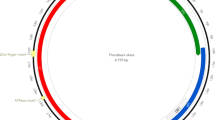Summary
The growth of four viruses isolated from lizards in Brazil (Marco, Chaco, and Timbo viruses) and Australia (Almpiwar virus) was studied in a variety of continuous cell lines of mammalian, reptilian, amphibian, and piscine origin. Although replication was found in certain cell lines derived from the coldblooded species, cytopathic effect (CPE) was absent or minimal and growth was less than or equal to that in mammalian cells. These observations appear to limit the value of poikilothermic cells for primary isolation of viruses from field-collected, coldblooded vertebrates or arthropods that feed upon them. The four reptilian viruses were found to be naturally occurring temperature sensitive agents, with optima for growth of approximately 30° C. Electron microscope studies showed three of the viruses (Marco, Chaco, and Timbo) to be new members of the familyRhabdoviridae. Marco virus particles were conically shaped and resembled bovine ephemeral fever virus, and two lyssaviruses (Kotonkan and Obodhiang). Chaco and Timbo viruses were cylindrical viruses resembling other rhabdoviruses with particle lengths longer than the prototype VSV. No serologic relationships were found in cross complement fixation tests between these viruses, Marco virus, and 34 other rhabdoviruses.
Similar content being viewed by others
References
Thomas, L. A., Eklund, C. M.: Overwintering of western equine encephalomyelitis virus in experimentally infected garter snakes and transmission to mosquitoes. Proc. Soc. exp. Biol. Med.105, 52–55 (1960).
Gebhardt, L. P., Stanton, G. J., Itill, D. W., Collett, G. E.: Natural over-wintering hosts of the virus of western equine encephalitis. New Engl. J. Med.271, 172–176 (1964).
Bowen, G. S.: Prolonged western equine encephalitis viremia in the Texas tortoise(Gophus berlandieri). Amer. J. trop. Med. Hyg.26, 171–175 (1977).
Craighead, J. E., Shelokov, A., Peralta, P.: The lizard: a possible host for eastern equine encephalitis virus in Panama. Amer. J. Hyg.76, 82–87 (1962).
Shortridge, K. F., Oya, A., Kobayashi, M., Yip, D. Y.: Arbovirus infections in reptiles: studies on the presence of Japanese encephalitis virus antibody in the plasma of the turtle,Trionyx sinensis. SE Asian J. trop. Med. Pub. Hlth.6, 161–169 (1975).
Hoff, G., Trainer, D. O.: Arbovirus in reptiles: Isolation of a Bunyamwera group virus from a naturally-infected turtle. J. Herpetol.7, 55–62 (1973).
Berge, T. O. (ed.): International Catalogue of Arboviruses, U.S. Dept. Hlth. Educ. Welf., Publ. No. (CDC) 75-8301 (1975).
Causey, O. R., Shope, R. E., Bensabath, G.: Marco, Timbo, and Chaco, newly recognized arboviruses from lizards in Brazil. Amer. J. trop. Med. Hyg.15, 239 to 243 (1966).
Clark, H. F., Karzon, D. T.: Terrapene heart (TH-1), a continuous cell line from the heart of the box turtle,Terrapene carolina. Exp. Cell Res.48, 263–268 (1967).
Clark, H. F., Cohen, M. M., Karzone, D. T.: Characterization of reptilian cell lines established at incubation temperatures of 23 to 36°. Proc. Soc. exp. Biol. Med.133, 1039–1047 (1970).
Clark, H. F., Cohen, M. M., Lunger, P. D.: Comparative characterization of a C-type virus-producing cell line (VSW) and a virus-free cell line (VH2) fromVipera russelli. J. Natl. Cancer Inst.51, 645–657 (1973).
Clarke, D. H., Casals, J.: Techniques for hemagglutination and hemagglutination-inhibition with arthropod-borne viruses. Amer. J. trop. Med.7, 561–573 (1958).
Casals, J.: Immunological techniques for animal viruses. In:Maramorosch, K., Koprowski, H. (eds.), Methods in Virology3, 113–198. New York-London: Academic Press 1967.
Leake, C. J., Varma, M. G. R., Pudney, M.: Cytopathic effect and plaque formation by arboviruses in a continuous cell line (XTC-2) from the toadXenopus laevis. J. gen. Virol.35, 335–339 (1977).
Clark, H. F.: Growth and attenuation of rabies virus in cell cultures of reptilian origin. Proc. Soc. exp. Biol. Med.139, 1317–1325 (1972).
Lunger, P. D., Clark, H. F.: Host effect on vesicular stomatitis virus morphogenesis and “T” particle formation in reptilian, avian, and mammalian cell lines. In Vitro11, 239–246 (1975).
Clark, H. F., Soriano, E. Z.: Fish rhabdovirus replication in nonpiscine cell culture: new system for the study of rhabdovirus-cell interaction in which the virus and cell have different temperature optima. Infect. Immun.10, 180–188 (1974).
Clark, H. F., Karzone, D. T.: Temperature optima of mammalian and amphibian viruses in cell cultures of homeothermic and poikilothermic origin. Arch. ges. Virusforsch.23, 270–279 (1968).
Author information
Authors and Affiliations
Additional information
With 3 Figures
Rights and permissions
About this article
Cite this article
Monath, T.P., Cropp, C.B., Frazier, C.L. et al. Viruses isolated from reptiles: Identification of three new members of the familyRhabdoviridae . Archives of Virology 60, 1–12 (1979). https://doi.org/10.1007/BF01318092
Received:
Accepted:
Issue Date:
DOI: https://doi.org/10.1007/BF01318092




